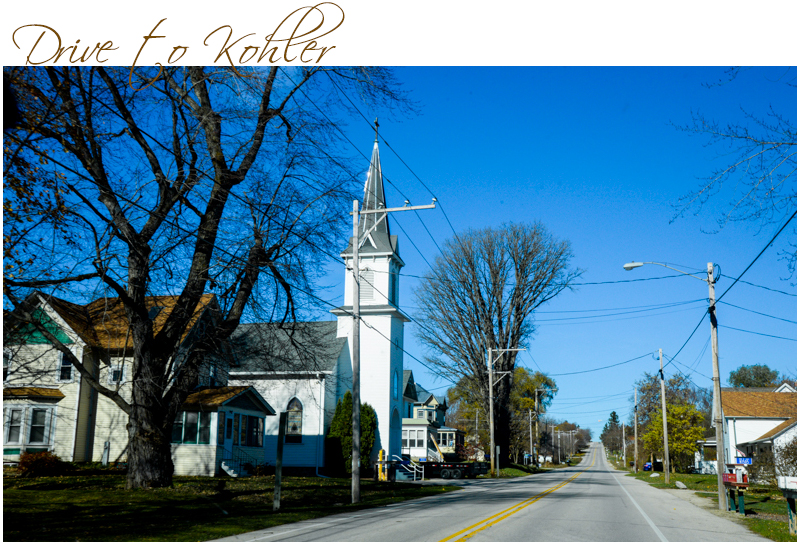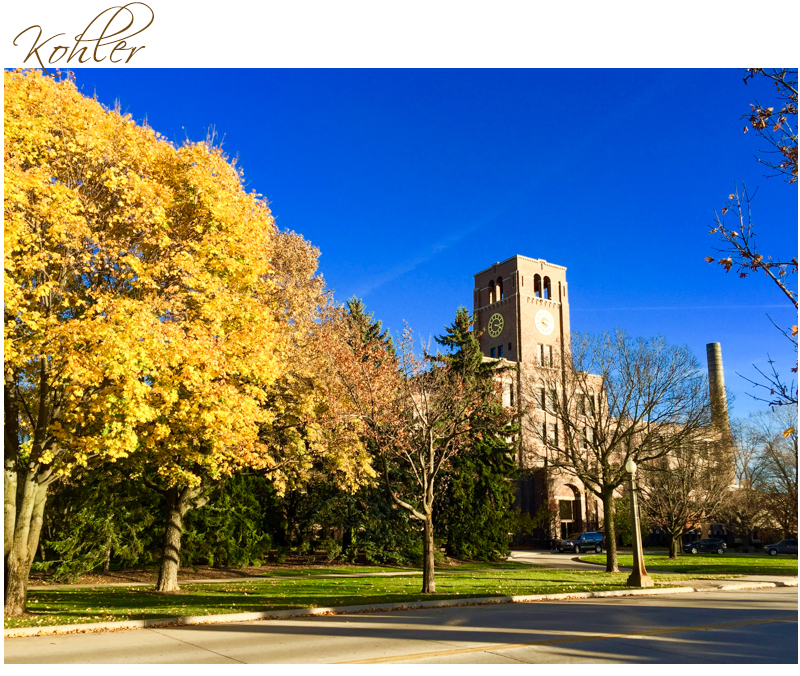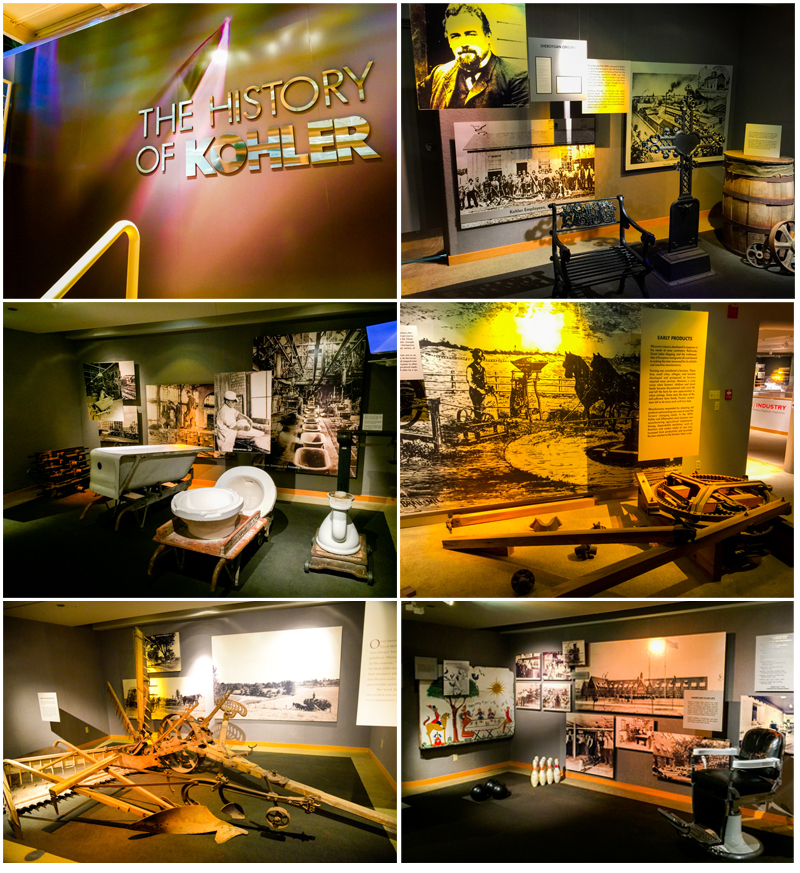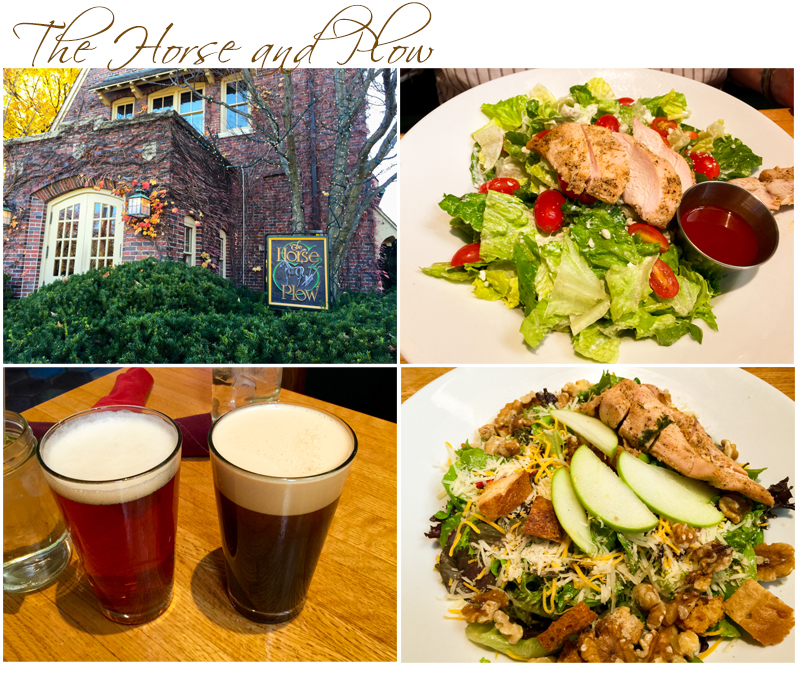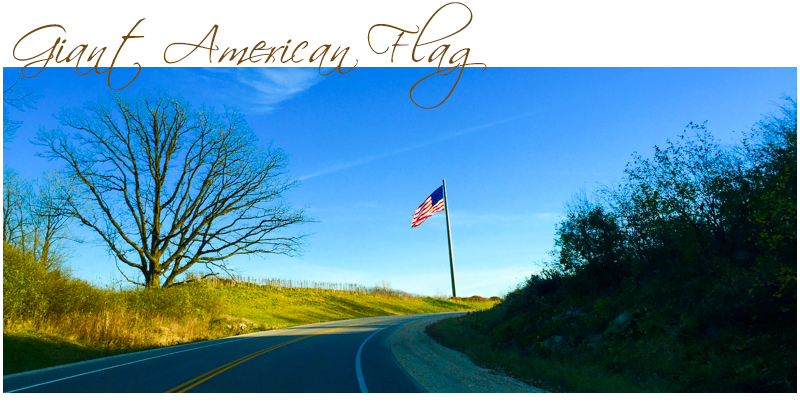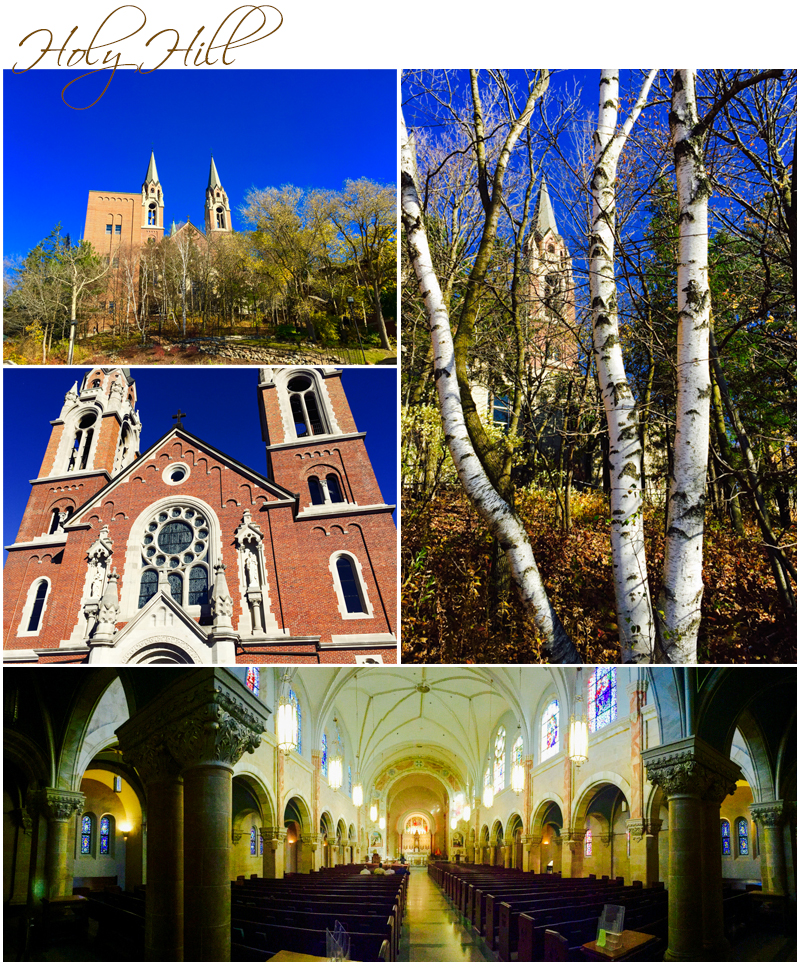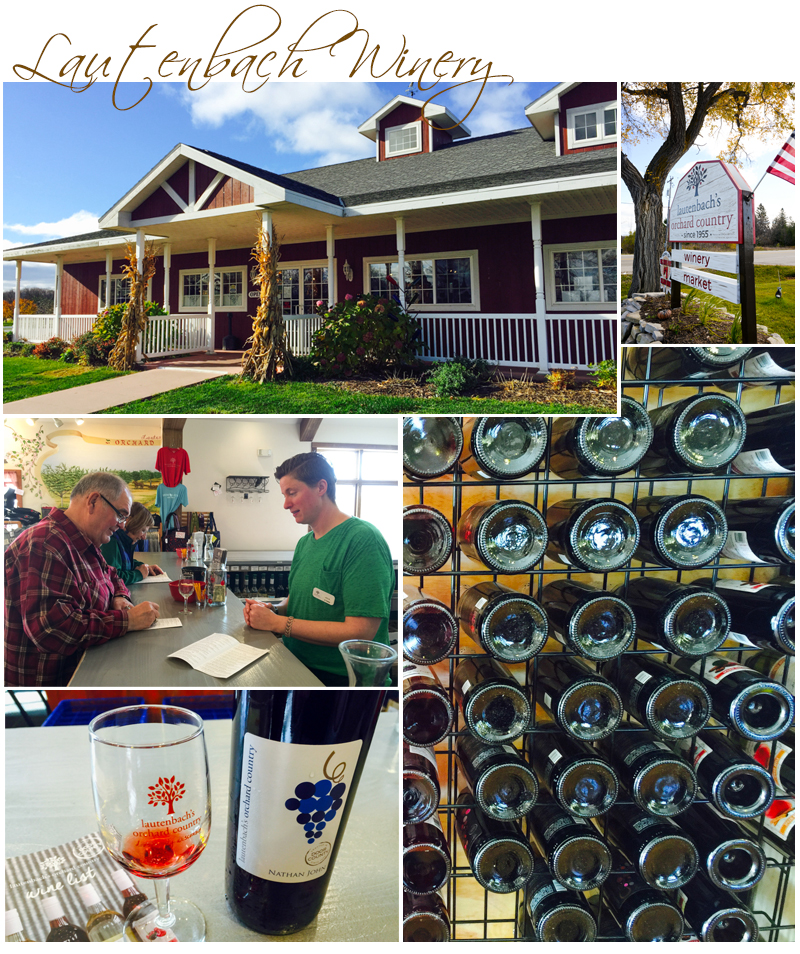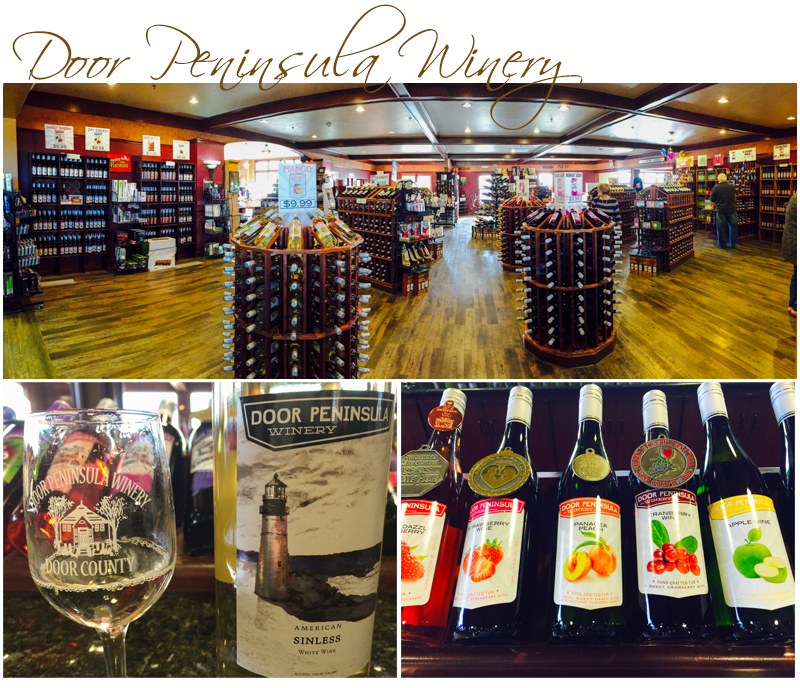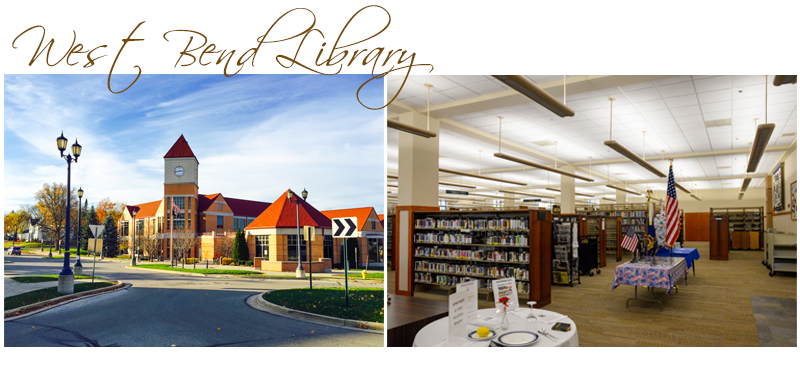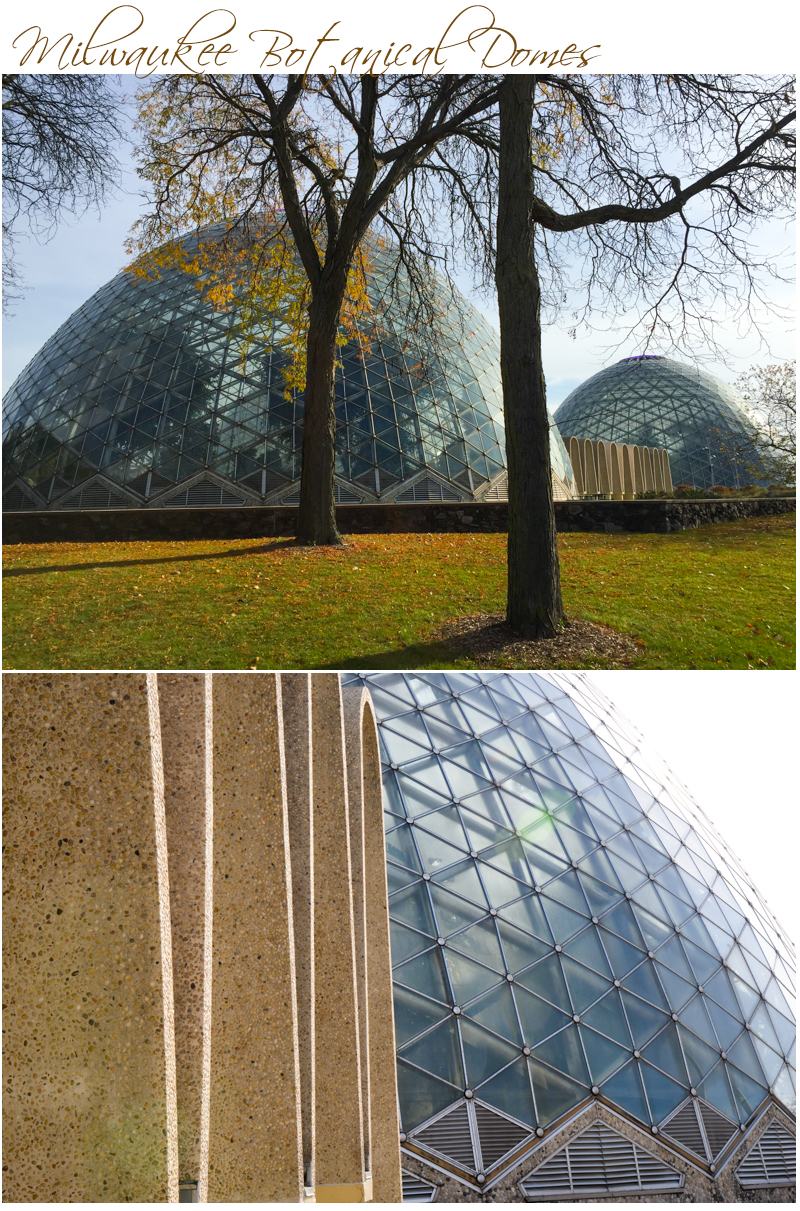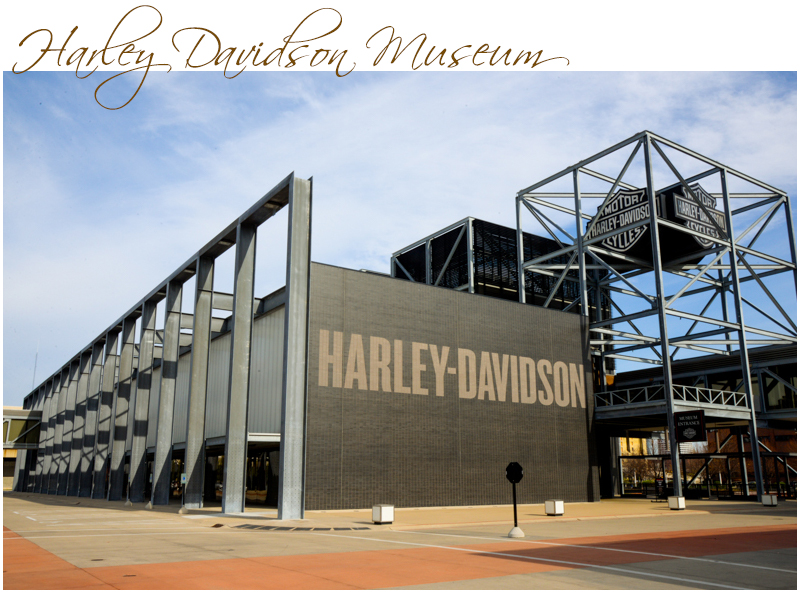” …There’s hundreds of stunning motorcycles on display, from Harley Davidson’s earliest manufacture, to the present day. I’m personally particularly impressed with the vintage and earliest models, and there’s several bikes for most of the years on display, all colours all descriptions. A delivery bike and side car, a police bike, war bikes, racing bikes, show bikes, choppers and famous bikes.
The Museum is scattered across three levels, the first level features the Museum entry and it also houses, hidden away, the last section of the museum visitors see, the show bikes, collector’s bikes and current models available. Immediately upon entry however, the visitor goes up to level two where vintage and period bikes, racing, and bike memorabilia including minutes from the first meeting of the Harley Davidson Company, posters, advertising, spare parts and packaging, photographs, and founding company photographs of personalities. There’s also a walk through gallery of racing photography, accessories, a fabulous wall display of fuel tanks and other static displays showcasing dress and uniform, and other relevant memorabilia that is associated with Harley Davidson. It’s comprehensive. As well, a research area and design area. The third level is a fully decked out workshop, fenced off from the public, but it allows visual access, and it contains rack after rack of bikes either being restored and repaired, or simply parked in storage racks ready for future attention It’s a fabulous, fascinating Museum, and full of the most exquisite mechanical motorbike eye candy. I don’t own a Harley but I can fully appreciate the sheer joy of owning one of these beautiful bikes. I know my father would have loved this place. Such detail, such history, comprehensive displays and stunning exhibits … “
Day Fifty Six – 9th. November – Wednesday – Wisconsin is the dairy state and occasionally as we drive its roads I see herds of black and white Holstein cows typical of the state’s dairy industry. There is a lot of cheese making done in Wisconsin, I am told, everywhere I go.
In 1841, Mrs. Anne Pickett started the first home cheese factory in Wisconsin near Lake Mills. Mrs. Pickett used milk from her neighbours’ cows to produce butter and cheese in her log cabin and this procedure continued until 1845, when the level of production and demand grew too large for her kitchen. By 1869, Wisconsin at large produced over 3 million pounds of cheese, and that number then quadrupled within 10 years. Brick cheese was invented in Dodge County, Wisconsin, in 1877 and is named for its shape and because cheesemakers originally used bricks to press moisture from the cheese. In 1885, the famous Colby cheese was invented in Colby, Wisconsin and in 1921, Wisconsin became the first state to establish cheese-grading standards to ensure consistent quality and flavour.
It takes ten pounds of milk to make one pound of cheese. Mozzarella cheese is the biggest-selling cheese variety in the United States, followed by Cheddar and Americans eat about 350 slices of pizza per second. That’s enough to cover more than 90 football fields a day. Wisconsin today leads the nation in number of cheese plants with 127 more than twice as many as any other state and Dairy is the largest segment of Wisconsin agriculture. Total Ag I check on the Internet is = $88.3 billion of which dairy = $43.4 billion. Also today 90% of Wisconsin’s milk is made into cheese and 90% of that famous Wisconsin Cheese is sold outside of the state’s borders. Wisconsin cheesemakers produce over 600 varieties, types and styles of cheese; the runner-up to Wisconsin comes in a distant second with 250 varieties.
So it is a farming state. As we travel to Kohler, our destination today, I am seeing agriculture utilising rich volcanic soils. The earth is chocolate brown, fertile and fecund with nutrients. The landscape is gently undulating and the farms we pass by have similar layouts, the typical red barns with white trim, tall thin blue or grey silos, outbuildings with both new and some older stone buildings, and a home, usually two or three stories, built in the typical American heritage style, timber with, attic peaked windows on the top, of generous proportion, and usually in good upkeep.
There are many towns. Small settlements, but thickly populated as compared to the remote isolated settlements I am used to seeing in Australia. Everything outside my window is of interest. The corn left to mature as long as possible in the fields, until the stalks are almost rotten, richly fresh turned fallow soils, the almost complete absence of farm fencing, woodlands every few miles and the preoccupation with patriotism and flying the American flag which seems to be everywhere, and on every second house. More predominant than pumpkins and Halloween I observe.
We arrive in Kohler and KP takes me to visit the Kohler design centre, a modern architectural designed building to showcase this company’s range of goods, from hand basins and bathroom tap ware, to toilets, baths and shower outfits and recesses, kitchenware, sinks, kitchen taps ware, laundry and engines.
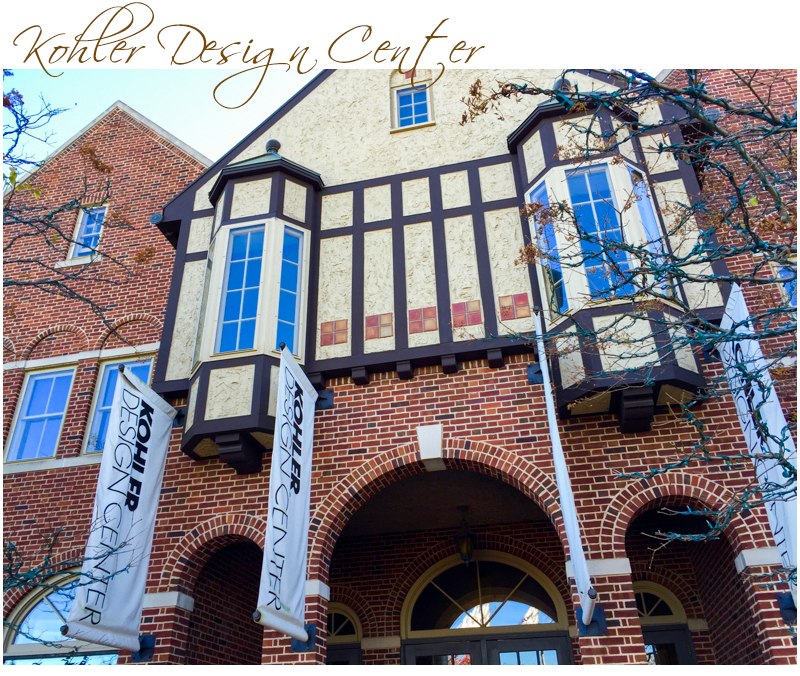 The company Kohler Co. was co-founded in 1873 by Austrian immigrant John Michael Kohler and Charles Silberzahn with the purchase of the Sheboygan Union Iron and Steel Foundry from Kohler’s father-in-law, Jacob Vollrath for $5000. Early products included cast iron and steel farm implements, castings for furniture factories, and ornamental iron pieces including cemetery crosses and settees. A breakthrough came in 1883 when John Michael applied enamel to a cast iron horse trough to create the company’s first bathtub. The company has been primarily in the plumbing business ever since, and is known for its plumbing fixtures.
The company Kohler Co. was co-founded in 1873 by Austrian immigrant John Michael Kohler and Charles Silberzahn with the purchase of the Sheboygan Union Iron and Steel Foundry from Kohler’s father-in-law, Jacob Vollrath for $5000. Early products included cast iron and steel farm implements, castings for furniture factories, and ornamental iron pieces including cemetery crosses and settees. A breakthrough came in 1883 when John Michael applied enamel to a cast iron horse trough to create the company’s first bathtub. The company has been primarily in the plumbing business ever since, and is known for its plumbing fixtures.

 Today Kohler’s bath and kitchen fixtures are available in American hardware stores and from Kohler Kitchen and Bath distributors. Kohler still makes traditional cast iron bathtubs, and besides residential products, Kohler manufactures a commercial line of bathroom fixtures. The company also does artistic custom work, such as hand-painted sinks and toilets. Kohler was named by “The Builder Magazine” as the “most used” and “best quality” in the “Bath Accessories” category as well as the top spot for “brand familiarity”, “most used” and “quality rating” in the “Bath Fixtures” and “Whirlpool Baths” categories.
Today Kohler’s bath and kitchen fixtures are available in American hardware stores and from Kohler Kitchen and Bath distributors. Kohler still makes traditional cast iron bathtubs, and besides residential products, Kohler manufactures a commercial line of bathroom fixtures. The company also does artistic custom work, such as hand-painted sinks and toilets. Kohler was named by “The Builder Magazine” as the “most used” and “best quality” in the “Bath Accessories” category as well as the top spot for “brand familiarity”, “most used” and “quality rating” in the “Bath Fixtures” and “Whirlpool Baths” categories.
Kohler also makes a wide range of small industrial engines. Traditionally, the company manufactured gasoline engines, however, after purchasing the Italian company Lombardini, it extended its range and now offers Diesel engines up to 134 HP. Kohler engines power a range of devices from water pumps to off-road vehicles.
We then head to the nearby Horse and Plow, part of Kohler’s American Club. KP and I sample more craft beers, KP has an Amherst Porter called Central Waters Mudpuppy Nitro and I have a Sheboygan Amber ale called Wisconsin Craft 3 Sheeps with our salad lunch, and mine, a walnut and apple with green leaves salad has a delicious spicy nut sauce with a grilled chicken breast and is, for once, exactly what I imagine I might be served after I order.
The trek south west back to West Bend this afternoon is via Port Washington. The road runs past a gigantic flagpole, Wisconsin’s largest, on the way. It is huge as KP tells me eighty mph winds blew the previous pole over, so the current one which replaced it, was made much sturdier.
Port Washington sits on the edge of Lake Michigan. It’s just on sundown at 4:30 pm when we arrive and the colour in the sky is rich with pinks and yellow, and bathes the dock area in stunning hues. We walk a little way towards a lighthouse at the entrance to the dock area and the lake before me is huge stretching ahead as far as the eye can see.
We arrive back in West Bend via Myra, a tiny village where KP shows me an eighty acre farm he had thought of buying some years ago. It’s amongst a tiny pocket of civilisation set on a creek. Very pretty, then West Bend looms and we head back for a quiet evening.
Day Fifty Seven – 10th. November – Thursday – A short side trip on the way to the supermarket this morning takes us to the nearby West Bend Sewerage Works, a plant that KP is proud of as a city servant in the years as City Engineer prior to being Washington County Highway Commissioner. Although it was in existence prior to KP’s term there, he is impressed with its ability to restore the water from raw sewage to a clean state which is then returned into the Milwaukee River. Solids KP adds are sold to farmers as a fertiliser. We then head to get some groceries to see me out til Tuesday with breakfasts. After dropping the groceries back at the house we then set off on today’s excursion, a visit to Holy Hill.
The shrine is located atop a high hill in 400 acres (1.6 km2) of woods. Visitors can climb a 178-step observation tower there to view the Milwaukee skyline 30 miles (48 km) away. At approximately 1,350 feet (410 m) above sea level, it is one of the highest points in southeastern Wisconsin and it is located near Wisconsin’s Ice Age Trail. Tradition says that the hill was first discovered in 1673 by Father Marquette with Joliet. However, modern historians view this tradition as untrue, though Jesuits were likely the first Catholic Priests to discover the hill.
The United States government owned the land until 1855 and the hill was known as “Government Hill” for surveying work was done there. Forty acres were purchased by Fr. Paulhuber, from Salzburg, Austria. The first resident on the hill was a hermit named Francois Soubrio.
Around 1862, an area farmer found him living on the hill. Soubrio had heard about the hill and he had found an old French diary and map dated 1676 showing a cone-shaped mountain in Wisconsin. The diary described how the author placed a stone altar, raised a cross, and dedicated the hill to Jesus’ mother Mary. The diary account corresponds with Jesuit missionary work in the area between 1673 and 1679.
The name “Holy Hill” was first given to the place by Irish settlers in the area. Father George Strickner dedicated a log chapel as the first Shrine of Mary, Help of Christians on May 24, 1863. A set of wooden crosses were placed for the Stations of The Cross in 1875 and in the winter of 1879, Fr. Raess sent a proposal to Archbishop John Henni to construct a new shrine to Mary. Construction began that spring. Pilgrims began flocking to the shrine, and it was decided that a religious order should administer the shrine. A group of Discalced Carmelites came from Bavaria at the invitation of Archbishop Sebastian Messmer, and the Shrine of Mary was put under their care on June 26, 1906. The building now known as the Old Monastery Inn and Retreat Center was completed in 1920 whilst a second shrine was removed in 1925 so that a third shrine could be built. The cornerstone of the third and present shrine was placed by Archbishop Messmer on August 22, 1926. The present church was completed and consecrated in 1931.
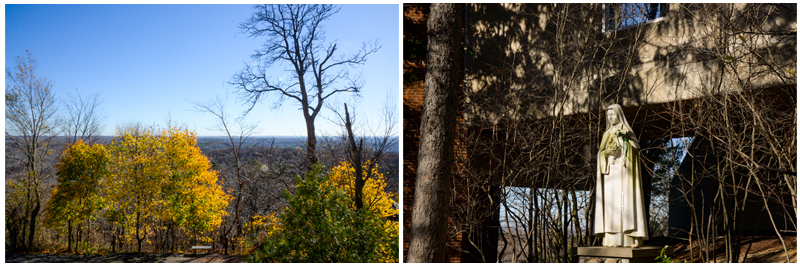 The church is a popular attraction for visitors to the area and as it’s a beautiful sunny day, there are quite a few cars in the car park when we arrive. The church has a huge gift shop, and nearby is a small cafe. KP and I take the fast route up, the elevator, and spend ten minutes inside enjoying the architecture and beautiful stained and coloured glass windows. KP points out that every pew, whilst similar in size and shape, have different carvings on the ends. It’s a subtle variation, but nice.
The church is a popular attraction for visitors to the area and as it’s a beautiful sunny day, there are quite a few cars in the car park when we arrive. The church has a huge gift shop, and nearby is a small cafe. KP and I take the fast route up, the elevator, and spend ten minutes inside enjoying the architecture and beautiful stained and coloured glass windows. KP points out that every pew, whilst similar in size and shape, have different carvings on the ends. It’s a subtle variation, but nice.
This afternoon is spent at KP’s as we plan to eat dinner tonight out. The soup I made some days ago much to KP’s amusement, is almost gone, so we polish that off with a nice glass of cold German Riesling for lunch. Then I settle into reading one of my books on ibooks and the afternoon passes quickly. Later in the day we head to Kewaskum fuelling the car up on the way, then we go to the Mexican restaurant The Limping Coyote across the road from KP’s favourite tavern in Kewaskum, The Fifth Quarter. We enjoy fajitas, corn fajitas, with chicken and steak, capsicum, onion and beans, rice, sour cream and guacamole. It’s a great meal and time passes quickly as we eat. After dinner go to the tavern then shortly after we head back to West Bend early as we leave to go to Green Bay and day of wine tasting at 7:00 am in the morning.
Day Fifty Eight – 11th. November – Friday – A 7:00 am departure this morning for KP, his ex work associate lady friend Barb and myself as we head to Green Bay and Egg Harbour.
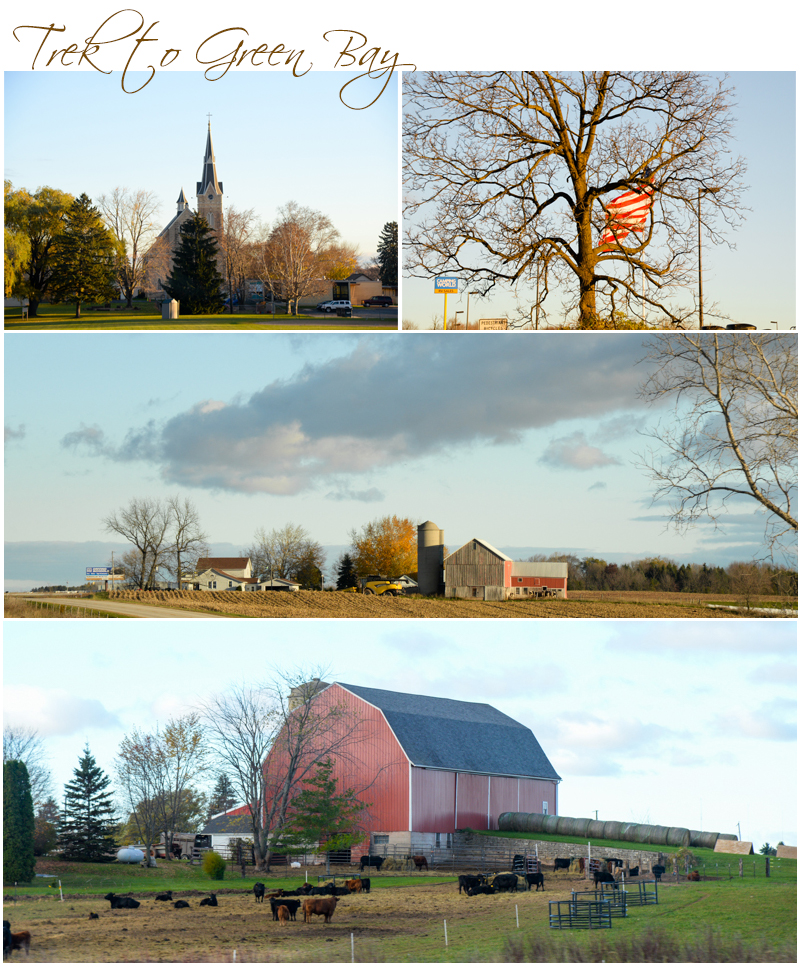 We arrive just before 10:00 am and find Chief Osh Kosh, the shop recommended to me to visit by Shannon (who coloured my hair whilst I was in New York State) is a small shop selling Native North American Art, but it is closed when we get there and due to open around noon. So we head towards the Peninsula State Park at Fish Creek a few miles further on from Egg Harbour to do a drive around Fish Creek as Ken and Barb wish to point out places to visit, eat and shop, where they’ve stayed and walked and visited. The drive in the park at Fish Creek is pretty but there’s almost no one here today as the season has finished, so we head to a couple of the lookouts and I take a few quick photos before heading back the way we came.
We arrive just before 10:00 am and find Chief Osh Kosh, the shop recommended to me to visit by Shannon (who coloured my hair whilst I was in New York State) is a small shop selling Native North American Art, but it is closed when we get there and due to open around noon. So we head towards the Peninsula State Park at Fish Creek a few miles further on from Egg Harbour to do a drive around Fish Creek as Ken and Barb wish to point out places to visit, eat and shop, where they’ve stayed and walked and visited. The drive in the park at Fish Creek is pretty but there’s almost no one here today as the season has finished, so we head to a couple of the lookouts and I take a few quick photos before heading back the way we came.
 By 10:30 am we arrive at the first of two wineries for tastings, Lautenbach Country Winery Market, and we all settle in to taste six wines. We haven’t had breakfast at this point, and I’m not buying yet, so I just enjoy the moment, and some really unusual tastes, particularly the warm spiced apple wine. Barb and KP do buy some wine however, and they leave with a dozen bottles between them. I buy two slices of cherry tart to take back to KP’s for us to eat in the next day or two. We manage to pass a half hour at the winery then decide that we should have an early lunch as Chief Osh Kosh still doesn’t open for another hour.
By 10:30 am we arrive at the first of two wineries for tastings, Lautenbach Country Winery Market, and we all settle in to taste six wines. We haven’t had breakfast at this point, and I’m not buying yet, so I just enjoy the moment, and some really unusual tastes, particularly the warm spiced apple wine. Barb and KP do buy some wine however, and they leave with a dozen bottles between them. I buy two slices of cherry tart to take back to KP’s for us to eat in the next day or two. We manage to pass a half hour at the winery then decide that we should have an early lunch as Chief Osh Kosh still doesn’t open for another hour.
We depart the roadside cafe at 12:30 pm then head to a Chief Osh Kosh where I introduce myself to Colleen, who runs the shop. She’s interested to meet me and asks me to sign her guest book. The store has mostly jewellery, some hair adornments like painted feathers, musical instruments, paintings and paper, hand carved jewel boxes, and so on, all Native American Art. I buy a ring for USD$35. My resources are quite tight by now on my trip, so I restrict my souvenir spending in Wisconsin to this one item. It’s a beautiful silver ring with blue inlay behind tiny silver polar bears. Some silver and opal pieces were also lovely but I simply couldn’t find one in my ring size, at a reasonable price. We all say goodbye.

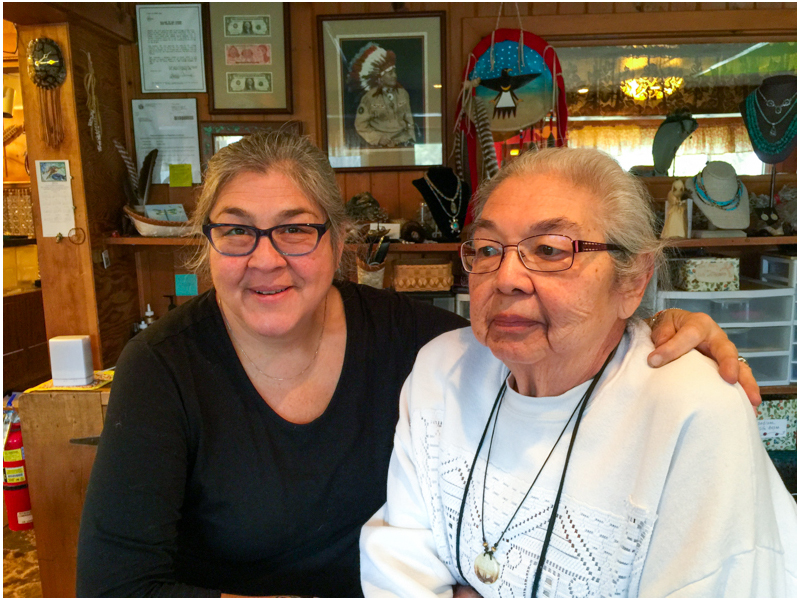 Our next stop on the wine trail is Door Peninsula Winery. Established in 1974 Door Peninsula Winery is Door County”s oldest winery celebrating its 40th. birthday in 2014. Door Peninsula Winery resides in the Old Carlsville schoolhouse, a two room school built in 1868 and despite many renovations the winery still retains much of its original schoolhouse charm such as the original bell, which is rung daily, stored in the bellhouse tower.
Our next stop on the wine trail is Door Peninsula Winery. Established in 1974 Door Peninsula Winery is Door County”s oldest winery celebrating its 40th. birthday in 2014. Door Peninsula Winery resides in the Old Carlsville schoolhouse, a two room school built in 1868 and despite many renovations the winery still retains much of its original schoolhouse charm such as the original bell, which is rung daily, stored in the bellhouse tower.
The winery started with only four wines in its earliest years and all wines were made in the schoolhouse’s original cellar which was a perfect wine making environment at the time with its thick walls and cool temperatures. Door Peninsula Winery has grown however, to become one of Wisconsin’s largest producing wineries making over 45 wines and consistently achieving many national awards. At Door Peninsula Winery we pay USD$3 for seven tasters. The serves are generous, more than at the last winery, and we settle into enjoying some more excellent wines from this fabulous wine growing region. Here I buy a bottle wine to take with me to leave on the bench for KP to enjoy after I depart. He has been generous escorting me around and keeping me company every day these last twelve days.
We arrive back in West Bend at 4:30 pm. Barb departs, Digger and KP go walking and I settle in writing notes and uploading pics on Facebook.
Day Fifty Nine – 12th. November – Saturday – A sleep-in this morning and by 11:00 am I am awake, had breakfast, and KP has returned from the Y. The cherry pie I bought yesterday is our lunch, and by 1:00 pm we venture out to today’s first destination the West Bend Museum of Art which is a wedge shaped building (known formerly as the West Bend Art Museum) and designed by Jim Shields, FAIA, Project Lead Designer at HGA Architects and Engineers (HGA). The building actually achieves a subtle balance between architecture as art, and, architecture as a neutral setting for art. The crisp, triangular geometry of the 31,000-square-foot, two-level museum moves from a glass-enclosed entrance at the southwest corner to a wedge-resolving point at the opposite end, where a glass curtain wall reveals an interior stairwell.
The building is clad in custom, horizontal, modular fibre-cement panels in three shades of white and the surface of the building projects a soft and gentle variegation of colour. It is a museum that collects and exhibits contemporary and historical art from the state of Wisconsin. Its collections include rotating historical and contemporary exhibitions and educational programs. The museum’s One Gallery features solo shows of contemporary Wisconsin artists and arts organisations several times each year.
Founded initially by the Pick family of West Bend, Wisconsin in 1961 to collect the works of Milwaukee-born artist Carl von Marr (1858-1936), the museum currently holds the most comprehensive collection of his work anywhere. In 1988, it broadened its focus to become a regional museum, rolling out a collection of Wisconsin artists spanning the years from 1820 to 1950. In 1998, its Early Wisconsin Art Collection was unveiled on the state’s sesquicentennial, reflecting its new mission to collect, conserve, document, and exhibit Wisconsin art through the ages. In January 2007, along with the name change, it began including both contemporary Wisconsin art, and work prior to 1820. The modern museum built by HGA Architects and Engineers was opened on the banks of the Milwaukee River in West Bend in April 2012.
There’re a lot of people at the museum today. A floral exhibition being featured was well advertised and opened today, so there’s a large number of market type stalls inside the museum featuring local artists’ exhibits for sale taking advantage of the unusually good number of visitors. I enjoy looking at the permanent collection and there’s a wide body of paintings from classic to contemporary / modern. And then I see an unusual sculpture with animals all over it. Somehow in America it is “normal” to see something like this, maybe even applauded, as hunting really is the true sport of this nation. I can imagine the byline though, “No animals were harmed in the making of this artwork.” Yeah right.
The museum’s featured artist, Carl von Marr has several pieces exhibited in the museum today and his painting with the most impact is a huge canvas, some twenty feet wide and fifteen feet high. “The Flagellants,” painted in 1889, is on permanent loan from the City of Milwaukee and it received a gold medal at the Munich Expositio in 1889.
From the Museum we head to the nearby West Bend Court House. A period German building that is now a historical museum. It is an iconic West Bend building and I’m told a lot of private functions are held there.
KP shows me through the building, the Court Room, Judge’s Chambers and museum exhibits showcasing some of the relevant historical events, war, settlement, area’s Indian presence and a huge survey plat map for Washington County dated around 1873-74. There’s alot of historical information on the walls, and an early document defining counties hangs on a wall. There’s also an enormous period donated doll’s house on display there which was once owned by a wealthy a West Bend family, complete with figurines, furniture and tiny Christmas decorations.
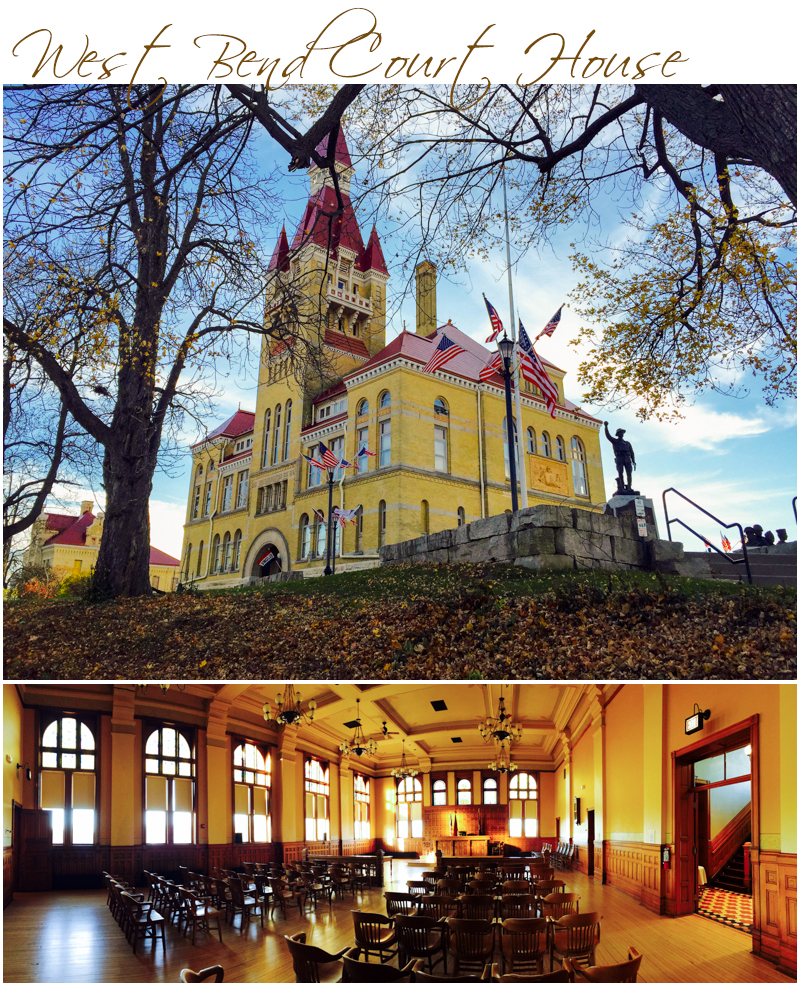
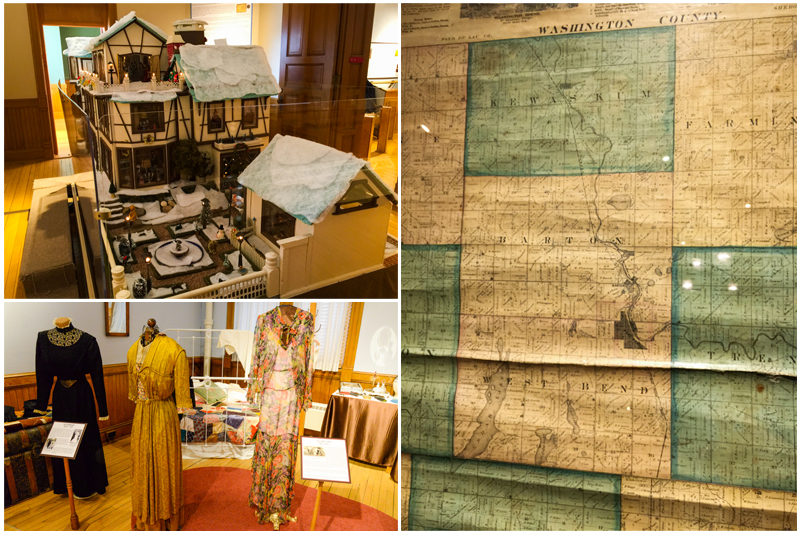 Leaving the museum we head across to the West Bend Library, a building KP was instrumental in building in 1998. Unfortunately the library is closed so we don’t get to see inside so then it’s back to KP’s to walk Digger. I hope to see the inside of this building however, before I leave. At 5:30 pm we head to Walden Supper Club on a small lake near KP’s for dinner. When we arrive at 5:45 pm, there’s a lot of cars in the car park. This place is popular and the restaurant is already full so, as we don’t have a booking, we are told a table will be available at 7:30 pm at the earliest. We decide instead to sit at the bar for a while then choose to sit at a table in the bar to get quicker service.
Leaving the museum we head across to the West Bend Library, a building KP was instrumental in building in 1998. Unfortunately the library is closed so we don’t get to see inside so then it’s back to KP’s to walk Digger. I hope to see the inside of this building however, before I leave. At 5:30 pm we head to Walden Supper Club on a small lake near KP’s for dinner. When we arrive at 5:45 pm, there’s a lot of cars in the car park. This place is popular and the restaurant is already full so, as we don’t have a booking, we are told a table will be available at 7:30 pm at the earliest. We decide instead to sit at the bar for a while then choose to sit at a table in the bar to get quicker service.
The meal here this evening is really good, I have Coconut and Pineapple Salsa, Battered Shrimp and French Fries, with Salad. KP has Prime Rib Steak, French Fries and Salad. Shrimp are prawns in the USA but they can be small or big. The prawns tonight were huge, succulent and very tender. Prime rib steak is a huge thick slice of steak from a slow cooked large roast. KP orders medium rare, and it arrives warmed through, and almost completely red with just a bit of brown searing on the outer edge. American Prime Rib is very tender but his meal doesn’t look anything like Prime Rib Steak or the Fillet Steak we have in Australia. It is however, cooked perfectly.
Day Sixty – 13th. November – I asked KP if he’d give Sue and Butch a call and organise a ride for me to go to Kettlebrook Community Church with them. I didn’t make a very convincing Catholic last week, so I’m hoping I fit in better at Kettlebrook. Sue arrives at 8:40 am to take me to their 9:00 am morning service. It’s a bit like Victory Church in Bendigo with its format and although I know none of their songs, the service is interesting and the time here passes quickly.
We plan to stay for coffee but Sue rushes around saying hello to people leaving me alone so I enjoy a quiet coffee before we make headway back to West Bend. Sue’s leaving for Florida tomorrow morning so she tells me she needs to get home and pack.
KP asks me what I’d like to do today. I say I’m not particularly fussed today but that I’d like to go to Milwaukee tomorrow, as tomorrow is my last day in Wisconsin, and that I’d like to see the Harley Davidson Museum and the Dome’s in the Botanical Gardens, so I ask KP to choose today’s outing. When Sue and I get back from church it’s late in the morning so I figure KP and I will probably do something really local.
KP makes a phone call then we head to New Prospect around 1:00 pm via Kewaskum and Auburn Lake. Today we are having lunch at Woodland Creek Supper Club. It’s at a very pretty spot set on Woodland Creek. It’s a typical American restaurant, a little bit kitch, and here there are bear skins and snow shoes tacked to the walls.  Then we head off to our next stop, Kelley’s Ice Creamery, in the middle of absolutely nowhere. Dessert is at 3:00 pm. It’s been a relaxing, fun day and we head back to West Bend, KP to walk Digger, and me to write up my notes. It’s a pretty drive back. The sky is a stunning blue as the day draws to a close and the surrounding farming land is bathed in the rich golds of a slowly setting sun.
Then we head off to our next stop, Kelley’s Ice Creamery, in the middle of absolutely nowhere. Dessert is at 3:00 pm. It’s been a relaxing, fun day and we head back to West Bend, KP to walk Digger, and me to write up my notes. It’s a pretty drive back. The sky is a stunning blue as the day draws to a close and the surrounding farming land is bathed in the rich golds of a slowly setting sun.
Day Sixty One – 14th. November – Monday – My last full day in Wisconsin which is also my oldest son’s 34th. birthday. I send him a text as he doesn’t answer his phone. It’s an early start for us as we are driving to Milwaukee to visit the Botanical Domes, the Harley Davidson Museum and to have lunch at a German Restaurant called Maher’s. It’s a beautiful sunny day, blue skies again but cool and I feel that the weather must be going to turn around for the worse soon. I have had fourteen clear days of good weather and one day with a little rain whilst here. Remarkable.
Our first stop this morning however is the West Bend Library, a building KP was instrumental in planning. Beginning with 730 books in a small room over the old horse stable of the City fire station in 1899, the West Bend Library is now located in the City cultural district near historical and art museums. A major expansion to more than 60,000 square feet on two floors, was completed in 1999-2000, and offers the community more space and services. Unfortunately they frown at me taking photos, and tell me to apply to the corrrect departments in writing to get approval to take photos but too late, I already have a couple of pics, and am leaving tomorrow. I’m a tourist and only interested in the building for what it is, a public building that was part of KP’s portfolio of achievements. I’m not wanting to linger or cause a drama.
The Botanical Domes are three large glasshouses and their architectural form on the skyline on Milwaukee is commanding. As we arrive however the domes are actually a lot smaller than I had first thought. I have been peaking them in the distance each time we have visited Milwaukee. When we arrive we are immediately disappointed to find the first dome closed. That leaves very little to look at as there wasn’t a lot to begin with.
The second dome, the Desert Dome and third dome, the Tropical Dome are open however and it’s a short but pleasant visit to each as housed inside is just a tiny sample of what you might find in typical North American environments. Also today seems to be the day for large play groups to visit the domes this morning, with often two parents accompanying their toddlers, or grandparents and parents, so there’s a lot of people here. It’s busy, and not at all peaceful.
I enjoy the structures themselves more than the exhibits, however the plastic fake rattlesnake and fake rocks in the desert dome, and the fake large concrete frog in the tropical dome, try hard to be convincing in this entirely artificial environment. Never mind the scissor lift and four workers inside the desert dome attempting to remove a tall and very large dead cactus. I’m not sure why maintenance has to be during hours, as the dome that is closed is also closed for maintenance. And the domes are tiny. I believe the next stop on our itinerary today is going to be a more enjoyable.
The Harley Davidson Museum in Milwaukee is in the city which is the actual home of Harley Davidson, and the building, a modern industrial architect designed structure suits the Museum’s personality extremely well. The exhibits are comprehensive and in pristine condition. The most outstanding feature throughout each exhibit are the motorbikes, with their rich coloured enamel bodies, lustrous chrome, black leather, and black tyre additions.
There’s hundreds of stunning motorcycles on display, from Harley Davidson’s earliest manufacture, to the present day. I’m personally particularly impressed with the vintage and earliest models, and there’s several bikes for most of the years on display, all colours all descriptions. A delivery bike and side car, a police bike, war bikes, racing bikes, show bikes, choppers and famous bikes.
The Museum is scattered across three levels, the first level features the Museum entry and it also houses, hidden away, the last section of the museum visitors see, the show bikes, collector’s bikes and current models available. Immediately upon entry however, the visitor goes up to level two where vintage and period bikes, racing, and bike memorabilia including minutes from the first meeting of the Harley Davidson Company, posters, advertising, spare parts and packaging, photographs, and founding company photographs of personalities. There’s also a walk through gallery of racing photography, accessories, a fabulous wall display of fuel tanks and other static displays show casing dress and uniform, and other relevant memorabilia that is associated with Harley Davidson. It’s comprehensive. As well, a research area and design area. The third level is a fully decked out workshop, fenced off from the public, but it allows visual access, and it contains rack after rack of bikes either being restored and repaired, or simply parked in storage racks ready for future attention.
It’s a fabulous, fascinating Museum, and full of the most exquisite mechanical motorbike eye candy. I don’t own a Harley but I can fully appreciate, the sheer joy of owning one of these beautiful bikes. I know my father would have loved this place. Such detail, such history, comprehensive displays and stunning exhibits.
I go to the Harley Davidson gift shop for a few minutes after we leave and look at all the paraphernalia one can buy as a token of the visit.
From the Harley Davidson Museum KP and I visit a German Restaurant a couple of miles closer to town then we drive back to West Bend and arrive back about 3:30 pm in time for Digger’s walk.
I picked up a large map of Wisconsin at the Museum earlier today, I ask KP to mark our treks on it for me with a fine black marker. We’ve covered over 1500 miles on our journeys around the area over the past two weeks and I’ve been very fortunate to see a lot of the local countryside, often taking different routes, to and from our destinations.
Day Sixty Two – 15th. November – Tuesday – I’m up at 5:30 am this morning to shower, wash and dry my hair, and finish packing ready to leave for Chicago with KP this morning at 7:00 am. We stop and buy a coffee and turkey sandwich at West Bend’s Starbucks’ drive through, then head off into pea soup fog towards Chicago. The traffic is thick from the get go. Firstly heading towards Milwaukee, then after a lull of about half an hour, it’s even more congested heading towards Chicago.
We arrive at Terminal Three at 9:40 am, and unload my bags then I bid KP farewell. I’m not sure if he’s glad to see the last of me or not but I do know I’ve certainly given him some variation to his daily routines, and I hope, scintillating company during the time I’ve been here. Haha. Right. A confirmed bachelor, taken out of his comfort zone by a visiting Australian female whose voice is too soft and has a weird accent (according to KP.) Well. It’s not my fault I don’t speak or think like an American.
The wait until departure is considerable this morning, almost three hours, so I have breakfast at the Terminal after checking in. Security is not over the top so I’m at a restaurant near my departure gate quickly. I also catch up on some emails using free wifi then head to the lounge to wait for the boarding call. The fog has slowed all departure and arrival flights today though so my flight is to sit on the Tarmac an extra thirty minutes in a queue. I check in my hand luggage then board the plane when it is time.
The take off and flight is smooth today and we are immediately heading over cropping country. Below I see huge circles where farmers irrigate farmland and tiny orderly settlements scattered across the landscape then two and a half hours into the flight and we pass over rugged mountains. I look out the window and below the peaks of the highest ridges that are brushed with a blanket of snow. They look so close I feel I could reach out and touch them, but we are so high up that I can see the areas that also surround the mountains, far off into the distance on all sides. They just fall away to more subtle rises. Rivers cut their way below between the massive peaks, eroding their way to the lowest points, joining forces as they journey downwards. Soon however, we pass the highest peaks by, and the landscape below falls away well below the higher flat plateaus.
I am now heading to San Fransisco to visit with PZ, an American friend whom I met on my trip to Southern Spain, Portugal and Morocco in 2014 and I’m very much looking forward to staying with her and her dog Eva in Castro Valley. Like MB and KP, PZ also has a myriad of adventures lined up for the next ten days and I’m thrilled to be seeing her again and to be sharing this experience with her.
It is a fabulous flight, I have a window seat and there is much to see outside. The plane treks above Tarkio Missouri; Atwood Kansas; Carbondale, Basalt and Grand Junction Colorado; Mesa County and Grand County Utah and Colorado; then finally Tonopah Nevada and San Francisco County and San Mateo County in California. How do I know? My iPhone records each image’s location. And as we arrive, below the plane is thick cloud, and below that, San Fransisco …
Go to Part Seven – California – Around The World In Seventy Five Days https://www.travelessae.com.au/part-seven-california-around-the-world-in-seventy-five-days/ to continue with me on my journey around the globe …

